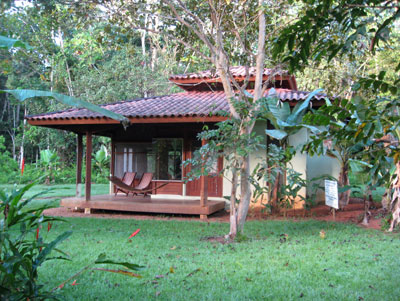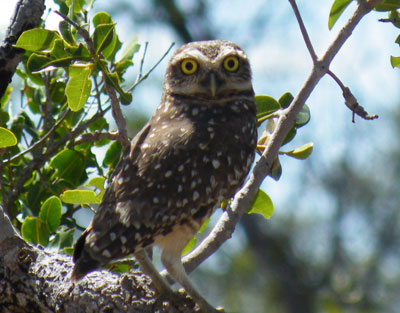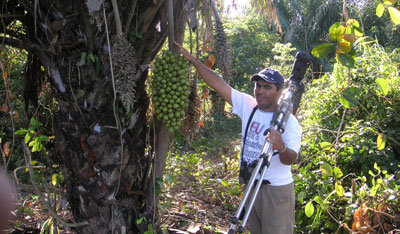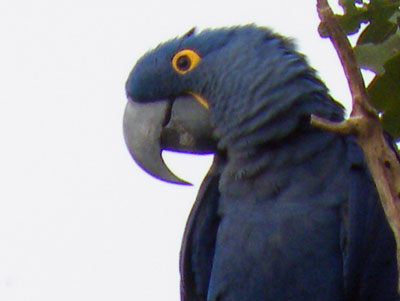Brazil — Exploring the Pantanal
by Frank & Judy Pease, Ottawa, KS
My wife, daughter and son-in-law and I traveled to Brazil in May ’08 to explore the state of Mato Grosso and the surrounding area. We flew to São Paulo, connecting to TAM Airlines for the flight to Cuiabá, where we were met by Eduardo Falcão de Arruda (cell +55 65 9958 4306, www.jaguarreserve.com), our guide for six days in the Pantanal.
Pantanal
At 81,060 square miles, the Pantanal is the largest inland wetland on Earth. Also extending into Bolivia and Paraguay, it lies in the Brazilian states of Mato Grosso and Mato Grosso do Sul.
During the wet season, from October to March, this natural basin floods up to 10 feet above the dry-season levels. While Africa may be the place to see animals more easily, the Pantanal supports up to 100 mammalian species, although they are well hidden by the lush flora.
The watching and photographing of some of the approximately 650 bird species, as well as numerous reptiles and amphibians, more than compensates for the paucity of mammals seen.
Our 6-night North Pantanal program was expertly planned by John Willemsen of Open Door (phone +55 67 3321 8303, www.opendoortur.com.br), a Dutch-Brazilian tour operator. He was very accommodating and responsive, and we highly recommend him for travel in Brazil.
From Cuiabá we traveled to Poconé, where we boarded our “safari vehicle,” a converted truck with benches in the back and a wooden cover. This vehicle was ideal for travel along the 90-mile dirt Transpantaneira Road from Poconé to its end at the Cuiabá River in Porto Jofre. However, those with back problems or other disabilities will find it very uncomfortable.
Ranch stay
We divided our trip into three sections so we could spend time viewing the numerous birds encountered along the way.
Our first stop was Hotel Fazenda Santa Tereza (Transpantaneira Road, km. 67), located next to the Pixaim River. Upon arrival, we discovered that the floodwaters had not yet receded from the fazenda’s long dirt driveway. Not to be deterred, Eduardo waded into the flood and decided it was safe to proceed. Soon we were enjoying a fine meal of chicken, rice with beans, and a variety of fruits and vegetables.
The fazenda is a working cattle ranch that was converted to an ecotourist destination with the addition of multiple nature trails, observation towers and habitat protection. Our rooms were comfortable, each with double beds and a bathroom with a hot shower. The dining room had an adjoining lounge with a library, comfortable chairs and field guides in both English and Portuguese.
Although Eduardo spoke excellent English, most of the fazenda staff spoke only Portuguese, but the food was excellent, the rooms were clean and the grounds, paths and towers were well maintained. There was even a small swimming pool!
During an early-morning stroll around the ranch, we saw toucans, parrots and even the beautiful sunbittern. Each turn brought a new discovery, and the viewing scope that Eduardo carried for us was quickly focused on the beautiful plumage.
After a full breakfast, we set out on the Pixaim River in a motorized boat to see capybaras and caimans by the river’s edge, howler and capuchin monkeys in the trees, and many more birds. On night safaris we saw an ocelot and even a tamandua (anteater). On the third day we continued south on the Transpantaneira Road deeper into the Pantanal.
Wildlife viewing
Our next stop was the Jaguar Ecological Reserve (phone/fax +55 65 3646 8557, www.jaguarreserve.com). The research facility there, established in 1999, is now abandoned, but the land has become a sanctuary and an excellent place to see wildlife.
Each of the lodge’s nine bungalows has twin beds and a bathroom with solar hot-water showers.
During our two days at the lodge, we saw hyacinth macaws, trogons and a very rare and seldom-seen puma. Eduardo was an excellent guide and he carried an iPod with small speakers that he used to call many different birds into view. After a dinner of beef, chicken, crêpes, rice, manioc, fruits and vegetables, and the obligatory siesta, we would have a night safari.
On the fifth day of our tour, we awoke to a tropical downpour. Although the rain lasted only a couple of hours, the dirt road became almost impassable.
Worse yet, a large, fully loaded fuel truck failed to negotiate one of the wooden plank bridges, breaking the bridge and blocking passage. As luck would have it, Eduardo was able to arrange a car swap with another group that was heading north and, after crossing the bridge on foot, we loaded into their vehicle and continued south to Porto Jofre.
Located at the farthest end of the Transpantaneira Road on the Cuiabá River, Hotel Porto Jofre (phone +65 3637 1593, www.portojofre.com.br, Portuguese only) is primarily a fishing resort. The bungalows each have a double bed and two twin beds, air-conditioning, a bath with a hot shower, and a covered veranda.
The cost for seven days and six nights of deluxe accommodation for this first portion of our trip, including all meals plus land travel, boat excursions and an English-speaking guide, was BRL2,319, or $1,423.
From Porto Jofre, we took a boat excursion up the Cuiabá River and were lucky to see giant river otters. These endangered animals can measure up to six feet from nose to tip of tail and usually travel in family groups. We saw them both in the water and climbing onto the banks to feed on freshly caught fish. We also saw the capped heron, kingfishers and more monkeys.
After dinner, we climbed back into the safari vehicle and began the long and difficult drive north to Cuiabá on the now deeply rutted and very slippery Transpantaneira Road.
Cuiabá
Founded in 1719, Cuiabá became the capital of Mato Grosso in 1835 and currently has a population of over 500,000 people. We stayed at the Amazon Plaza Hotel but found our room to be quite small and very sparse, with two double beds and no comfortable chairs. The hotel is, however, centrally located and near some very good restaurants. The cost for one night’s deluxe accommodation, including transfers and breakfast, was BRL178, or $109.
One day in Cuiabá is sufficient to see most of the unique aspects of this frontier town.
Cristalino Jungle Lodge
After a short flight from Cuiabá, we arrived at Alta Floresta and drove about two hours north to the banks of the Teles Pires River, where we found our guide, Jorge Lopes, waiting for us. An expert in both flora and fauna, with a special interest in photography, Jorge used his spotting scope and field guide to identify the many birds we saw.
The Cristalino Jungle Lodge (phone +55 66 3512 7100, www.cristalinolodge.com.br) is located about 30 minutes up the Cristalino River, part of the Amazon River system and a tributary of the Teles Pires River. The lodge includes a large dining hall, a separate library and many small bungalows. There are also numerous walking paths, a finely manicured lawn and grounds, a canopy tower, a screened tree house and a swimming dock.
We had a spacious 2-room bungalow with twin beds, a bathroom and a sitting area. The bungalow was very comfortable and private. Our 4-night stay, including accommodation with all meals, English-speaking guide and all boat excursions, cost BRL1,361, or $835.
Over the next four days we enjoyed several riverboat trips, including one to the Hoatzin Lagoons where these curious birds can be seen. Along the way, we discovered Saki monkeys and more howlers and capuchins. One morning we climbed the 150-foot-high tower to see the top of the jungle canopy and observe many birds that could not be seen from the ground.
We stayed overnight in the screened tree house to hear the howler monkeys and see the nocturnal animals that came to the natural clay lick. We photographed a tapir in the spotlight and saw many shadows of animals that we couldn’t identify.
The next day we swam in the Cristalino River and hiked along the many jungle trails, where Jorge helped us find the red-fan parrot, the lineated woodpecker and the musician wren as well as numerous other birds and plants.
Brasília and onward
At our next stop, Brasília, we stayed at the Brasília Alvorada Towers Hotel (phone +61 3429 8000), located next to the Presidential Palace. Our room was a deluxe suite with a king-sized bed, a separate sitting room with comfortable chairs, a large bathroom and all the amenities of a luxury hotel suite anywhere in the world. The cost for accommodation, including transfers and breakfast, was BRL181, or $111.
In the morning we met our English-speaking guide, Fernando Couto (e-mail tatoosj@yahoo.com.br), who would accompany us on the 13-hour bus ride from Brasília to Gilbués in the state of Piauí. With the help of Fernando, the bus ride was comfortable. We stopped for lunch and dinner at little cafés along the route, arriving at São Gonzalo do Gurguéia at 11 p.m. A “safari vehicle” took us the rest of the way to the Hyacinth Valley Lodge.
Parque Nacional das Nascentes do Rio Parnaíba is located in the southwestern part of Piauí, approximately 150 miles from the town of Barreiras. At about one-third the size of New Jersey, this relatively new national park is Brazil’s largest outside of the Amazon. It protects the largest dry tropical forest in the world.
Hyacinth Valley Lodge is located deep in this wilderness area and is accessed by dirt roads that are almost impassable due to the deep sandy soil and areas of erosion. Our cabin, which had a double bed, was comfortable although sparsely furnished. There was no hot water, but the bathroom was indoors. The meals were simple but very good and served in an open-air pavilion.
There were many bird feeders around the grounds providing constant enjoyment. We did not have any night safaris in this area, but we did travel to several areas of the park to see the beautiful red sandstone cliffs. Alas, we did not see the endangered maned wolf.
On one day we traveled three hours north to a different section of the park that was even more remote. We stayed in a tent that had a double bed, a makeshift portable toilet and an interesting shower fashioned from a galvanized bucket into which a showerhead had been screwed. There was no electricity and, once again, the water was heated by the sun.
We ate delicious meals, prepared over a wood stove, at a local rancher’s home. Here we were able to see the famous tool-using capuchin monkeys, documented by the National Geographic Society and still being studied for their habit of using complex tools to break open the hard coconuts upon which they feed.
The cost of our 4-night stay at the Hyacinth Valley Lodge, including all meals, English-speaking guide and transportation, was BRL2,364 ($1,451). Our arrangements here were made by Elizabeth Sanders of Tropical Nature Travel (Gainesville, FL; 877/888-1770, www.tropicalnaturetravel.com).





